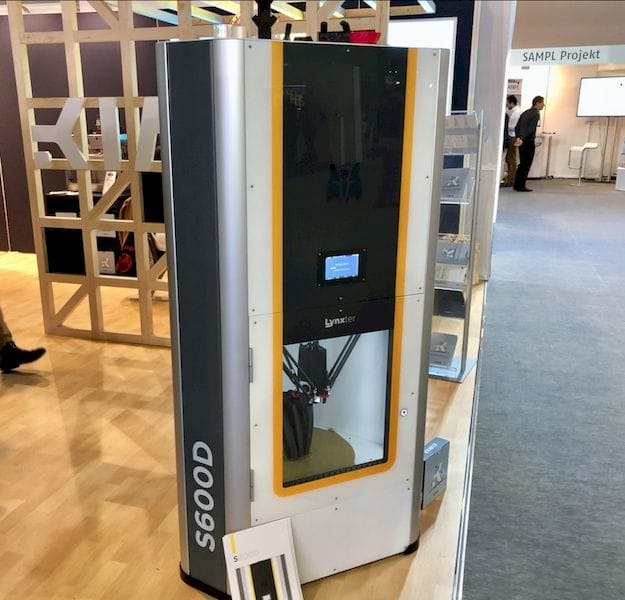![The Lynxter high-temperature 3D printer [Source: Fabbaloo]](https://fabbaloo.com/wp-content/uploads/2020/05/image-asset_img_5eb0a0e1cdfe2.jpg)
A French startup has developed a versatile high-temperature 3D printer.
Lynxter is the name of the company, and they’re based in Bayonne, France. We learned that the company began as a school project to produce a 3D printer. They won a contest, and the publicity generated resulted in a sale of a machine to aerospace giant Airbus. From there it was clear they needed to further commercialize their ideas in 3D printing.
Now their latest machine is the S600D, targeted at the education and prototyping market. This machine uses the classic delta-style design, but it includes an unusual extrusion system. It has a rather large 390mm diameter by 600mm tall build volume.
An unusual feature for a large-sized delta machines such as the S600D is that the build chamber is actively heated, and it does so up to 80C. That’s sufficiently hot to 3D print many types of engineering materials.
The S600D includes a number of other high-temperature features, including a print surface that can hit up to 150C, as we were told by their representative, more than their documented 130C specification. The toolhead itself and material input lines are separately water cooled to ensure they don’t prematurely heat up prior to actual extrusion. That’s an interesting feature I don’t recall seeing on other machines, let alone on a delta.
![Triple Bowden extruders on the Lynxter S600D 3D printer [Source: Fabbaloo]](https://fabbaloo.com/wp-content/uploads/2020/05/image-asset_img_5eb0a0e239733.jpg)
But the really interesting feature is their extrusion system. It’s a Bowden style arrangement, as shown here. The S600D uses 1.75mm filament, as opposed to the sometimes tricky to use 2.85mm filament often found on Bowden systems. Any filament material can be used, as this is an open materials system.
The toolhead itself includes three separate hot ends, as you might guess from the three Bowden extruders feeding it – all powered by the increasingly popular Bondtech technology. These are all ready to go during printing operations, making it possible to use multiple materials or colors. One likely usage scenario is to have one toolhead loaded with water-soluble support material to enable printing of complex geometries.
The hot ends appear to lift out of the way when they aren’t actively being used, thus eliminating a common cause of print failure: the inactive nozzles cannot bump into the print. The toolhead also includes a means to clean the nozzles so you won’t experience drips.
![Swappable tools on the 3-tool delta toolhead of the Lynxter S600D 3D printer [Source: Fabbaloo]](https://fabbaloo.com/wp-content/uploads/2020/05/image-asset_img_5eb0a0e28dd98.jpg)
If that wasn’t enough, the S600D tool system can be easily swapped for alternate tools when necessary. The tool is attached by magnetic ball joints and a few cables, and is said to be changeable in only five minutes. You can vary the system to accommodate wear resistance, surface detail, print speed and more.
![Swappable print plate on the Lynxter S600D 3D printer [Source: Fabbaloo]](https://fabbaloo.com/wp-content/uploads/2020/05/image-asset_img_5eb0a0e2d4fc6.jpg)
The print surface is entirely swappable to match the needs of the particular materials involved. For example, they offer a PEI plate for common materials, but also have glass or other surfaces available. Choose the best plate materials for the job!
Safety is also paramount to the S600D design, as it includes lockable build chamber doors as well as a dual stage HEPA H14 filtration system with activated carbon filters to remove most VOCs.
As you might expect in a sophisticated 3D printer, the S600D includes all normal automated calibrations.
![A flexible 3D print made on the Lynxter S600D [Source: Fabbaloo]](https://fabbaloo.com/wp-content/uploads/2020/05/image-asset_img_5eb0a0e332a87.jpg)
These features makes the S600D capable of easily 3D printing a very wide variety of engineering materials. Here we see an example of a flexible 3D print; this demonstrates the versatility of the S600D, as it can print tricky flexible material in addition to the high temperature filaments, including ASA, Nylon-carbon fiber, PEEK, ULTEM, PLA, PETT and many more.
The S600D is priced around €25K (US$28.5K) and is available now.











FELIXprinters has released a new bioprinter, the FELIX BIOprinter, which is quite a change for the long-time 3D printer manufacturer.